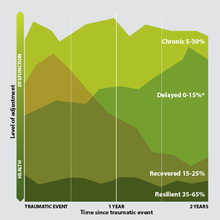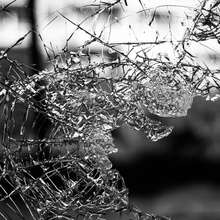For some people, the experience of traumatic events in the past keeps being relived in the present, making their bodies a battleground of anxiety, anger, sadness, and stress-related symptoms.
The experience of post traumatic stress (PTS) has sometimes been described as the failure of time to heal all wounds.
PTS involves exposure to a traumatic event followed by the experience of a response involving intense fear, helplessness or horror. When significant distress persists, it can become a chronic condition, causing impairment in social interactions and in important areas of daily functioning.
Factors that contribute to the intensity of the response to a traumatic experience include the degree of controllability, predictability, and perceived threat; the relative success of attempts to minimize injury to oneself or others; and actual loss.
If the individual is wounded or exposed to pain, heat, or cold, the biologic and psychological traumatic experience can be intensified.
Events that involve interpersonal violence give rise to PTS disorder (PTSD) more often than events such as motor vehicle accidents and natural disasters. For example, PTSD developed in 55% of persons who reported having been raped, as compared with 7.5 % of those involved in accidents, and 2% of those who learned of traumatic events.
One study reported that PTSD developed in approximately 14% of those who experienced the sudden, unexpected death of a loved one, making this the single most frequent traumatic event to occur in both men and women, accounting for 39% of cases of PTSD in men and 27% in women.
Clinical definition
PTSD and related disorders as defined by the American Psychiatric Association, APA, are listed in the DSM-5, the 5th Edition of the Diagnostic & Statistical Manual of Mental Disorders, released in May, 2013.
This is the standard classification of mental disorders used by mental health professionals in the US.
According to the APA, "posttraumatic stress disorder (PTSD) is a psychiatric disorder that can occur in people who have experienced or witnessed a traumatic event such as a natural disaster, a serious accident, a terrorist act, war/combat, rape or other violent personal assault.
It is a real illness that causes real suffering. People with PTSD continue to have intense, disturbing thoughts and feelings related to their experience that last long after the traumatic event has ended. "
Common symptoms
There are 4 main clusters of symptoms according to the APA:
- Re-experiencing: flashbacks, recurrent dreams or nightmares, or other prolonged or intense distress related to the event.
- Avoidance: distressing memories, feelings, thoughts from external reminders of the event.
- Negative cognitions and mood: mental states such as a persistent and distorted sense of blame to self or others, estrangement from others, loss of interest in activities, inability to remember key aspects of the traumatic event, a doomed sense of the future, or hopelessness.
- Hyper arousal: prone to startle, hypervigilance, sleep disturbances, aggressive or reckless or self-destructive behavior.
Almost half of those who experience severe trauma recover within weeks or months. However, 15-30% of individuals continue to struggle with the emotional and mental aftermath of trauma chronically, sometimes for years.
The debilitating effects of post traumatic stress severely impair an individual’s ability to meet family and social obligations, and to succeed in school and work. The fallout of trauma may lead to major depression, as well as alcohol and/or substance abuse, with each problem complicating and exacerbating the other.
Note from the editor: For PTSD self-assessment test or checklist, go to the reference list of this article.
Prevalence
Going through trauma is not rare. About 6 in every 10 men (or 60%) and 5 in every 10 women (or 50%) experience at least one trauma in their lives. Women are more likely to experience sexual assault and child sexual abuse. Men are more likely to experience accidents, physical assault, combat, disaster, or to witness death or injury.
Among the US population
- About 7 or 8 out of every 100 people (or 7-8% of the population) will have PTSD at some point in their lives.
- About 8 million adults have PTSD during a given year.
- About 10 of every 100 women (or 10%) develop PTSD sometime in their lives compared with about 4 of every 100 men (or 4%).
The estimated lifetime prevalence of PTSD among Vietnam war American veterans was 30.9% for men and 26.9% for women. The prevalence of PTSD of Gulf War Veterans was 12.1%, and for the Iraqi operation, the prevalence of PTSD was 13.8%.
Table 1 lists out the prevalence of different types of traumatic events among men and women, as well as the percentage of those who developed PTSD.
|
Traumatic event |
Prevalence of event (%) |
Percentage of those who developed PTSD (%) |
||
|
Men |
Women |
Men |
Women |
|
|
Rape* |
0.7 |
9.2 |
65.0 |
45.9 |
|
Molestation* |
2.8 |
12.3 |
12.2 |
26.5 |
|
Physical assault* |
11.1 |
6.9 |
1.8 |
21.3 |
|
Accident* |
25.0 |
13.8 |
6.3 |
8.8 |
|
Natural disaster* |
18.9 |
15.2 |
3.7 |
5.4 |
|
Combat* |
6.4 |
0.0 |
38.8 |
- |
|
Witnessed death or injury† |
40.1 |
18.6 |
9.1 |
2.8 |
|
Learned about a traumatic event† |
63.1 |
61.8 |
1.4 |
3.2 |
|
Any traumatic event* |
60.7 |
51.2 |
8.1 |
20.4 |
|
Any traumatic event† |
92.2 |
87.1 |
6.2 |
13.0 |
*Data are from Kessler et al.
†Data are from Breslau et al.





